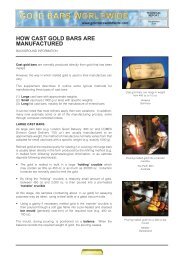Indian Gold Book:Indian Gold Book - Gold Bars Worldwide
Indian Gold Book:Indian Gold Book - Gold Bars Worldwide
Indian Gold Book:Indian Gold Book - Gold Bars Worldwide
Create successful ePaper yourself
Turn your PDF publications into a flip-book with our unique Google optimized e-Paper software.
GOLD JEWELLERY PRODUCTS<br />
This section covers caratages, the typical weights and relative importance of the 5 main product<br />
categories, and the variety of regional styles.<br />
K22 is the dominant caratage.<br />
The bangle is the most important product for most large retailers. accounting on average for around 30% of the weight<br />
of gold jewellery sold. A pair typically weighs between 12 g and 24 g.<br />
Kolkata is renowned for its intricate filigree jewellery.<br />
There is increasing consumer demand for innovative designs.<br />
CARATAGES<br />
Most plain gold jewellery is sold as K22, but K24, K23, K21 and K18 jewellery is also available.<br />
K22 jewellery is generally sold as “22/20”. This means that, when the item is melted down, its fine gold content will be<br />
approximately 10% less than its designated weight. This traditional practice takes into account gold wastage, and an<br />
extensive use of solders, in the fabrication of most handmade items.<br />
Since the introduction of voluntary hallmarking, and the use of solders such as cadmium, many large retailers are now<br />
selling jewellery that is “22/22”.<br />
K24 is often available to those customers, especially in some rural areas, who want simple, lower value added jewellery.<br />
K23 is also available, notably in the west and north. In Maharashtra, it can account for 20% (sometimes 90%) of jewellery<br />
sales in some outlets. In rural areas in the Punjab, K23 is widely sold.<br />
K21, a traditional caratage in the Middle East, is sometimes available .<br />
K18 is normally used for gold jewellery incorporating diamonds.<br />
IMPORTANT CATEGORIES<br />
There are 5 broad categories that normally account for the bulk of gold jewellery sales: necklaces, bangles,<br />
chains, earrings and finger rings.<br />
<strong>Gold</strong> usage<br />
The importance of each category, as a percentage of the total weight of gold jewellery sold, can vary greatly among<br />
retailers, even in the same locality.<br />
The table below records the variation among the large urban retailers visited.<br />
Category % Split of retail sales<br />
by weight<br />
Necklaces 10 - 35<br />
Bangles 20 - 50<br />
Chains 10 - 40<br />
Earrings 5 - 20<br />
Finger rings 5 - 10<br />
Other 5 - 10<br />
Total 100<br />
Bangles. Generally the most important category, typically around 30% of the total weight of gold jewellery sold. They are<br />
normally sold as pairs, sometimes 6 pairs or more at a time.<br />
Chains. Variable, even in the same locality. In the south, chains appear to be more important, typically 25 - 35%.<br />
Necklaces. Variable, but typically 15 - 20%. A marked decline in importance in many outlets over the past 5 years.<br />
The importance of earrings and finger rings tends to increase progressively down the distribution chain. In small rural and<br />
suburban outlets, their proportion often exceeds 50%. However, among many large retailers, their sale is also reported to<br />
be increasing.<br />
94<br />
AN INTRODUCTION TO THE INDIAN GOLD MARKET

















